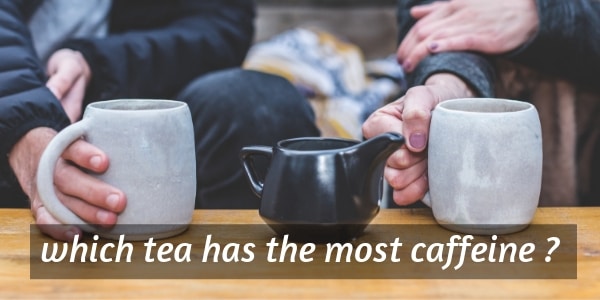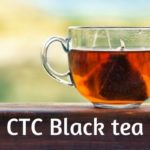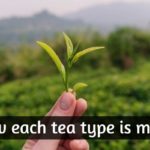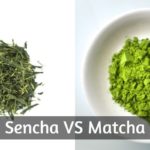Concerned about the caffeine level in your cup of tea ? Or are you trying to find a good morning tea, and would like to know which has the most caffeine ?
Whichever way you're curious, knowing the general levels of caffeine in each tea type is going to help you in the long run.
Be warned though, measuring caffeine in a brewed tea can be misleading, for a number of factors. I'll get into that as well.
Table of Contents
So which tea type has the most caffeine ?
Generally, the tea that steeps the longest will release the most caffeine.
In terms of steeping time, black tea will give you the most caffeine as it steeps the longest. The caffeine has time to remove itself from the tea leaves.
But in terms of actual caffeine content in the leaf, white tea is stronger. You don't hear about it often, because it's not steeped for very long, and people tend to miss the caffeine in it.
All this being said, there are many things that affect how much caffeine ends up in your cup of tea. I'll look into what those things are, and how you can extract the most caffeine from your tea.
Caffeine levels in tea have wide ranges
The level of caffeine in tea can be hard to measure precisely, since it varies from tea to tea. Even between black teas, not all of them are the same.
There are differences between two teas, made of the same type of plant, since they can be grown in different places in the world, in a different climate, with more or less sun, etc.
There is a general idea of how much caffeine is in each tea type, but there can't be an exact measurement.
Usually if you google the caffeine level in tea, you'll get a short answer of about 30-80 mg for 8 oz of brew.
That's not exactly helpful, but if you dive in deeper, you'll notice that no one really agrees on exactly how much caffeine is in each tea type.
There's a reason for that, several actually. I'll get into those a bit later in the article.
Until then, let's take a look at each tea type, and see its general caffeine profile so we can understand why everyone's so confused.
Short introduction to the tea plant
The usual plant used for teas is Camellia sinensis. It's naive to Asia, and has been grown for tea for thousands of years now.
There is another tea plant, Camellia Assamica. That's the one usually grown in India, but is now also grown in other parts of the world.
That's what Assam teas are made of.
When the harvesting time comes, the tea plant has 3 types of leaves to offer. Starting from the most caffeinated to the least, we have :
- tea bud, the youngest and most caffeinated
- young tea leaf, fresh and bright
- adult tea leaf, slightly older than the younger tea
Now that we know all this, let's look at each tea type in turn.
Black tea
Black tea tends to have the highest caffeine level of the bunch, since it steeps the longest, and at a higher temperature than other teas.
This is a bit ironic, seeing as black tea uses the older tea leaves, which normally contain less caffeine than young tea leaves, and tea buds.
But, teas made from leaves so young can't be steeped long.
Generally, Assam teas are stronger in taste and caffeine. Those are teas grown in India originally, and are now also grown in Sri Lanka (Ceylon) and Africa.
Green tea
This tea is usually made of the Camellia sinensis plant, and as such it's overall caffeine level will be lower than black tea, especially Assam black tea.
That's because green tea is steeped for much less time than black tea.
If black tea steeps for 3-5 minutes, green tea steeps for 2 minutes, possibly 3 if you're pushing it.
It's a very delicate tea, and is easy to overextract. When it does this, it becomes very bitter and barely drinkable.
White tea
White tea has more caffeine in it, or at least more potential than any other tea out there.
This is because for white tea, only tea buds are picked and used.
This means that the tea plant used is very young, and has the most caffeine.
For reference, black tea uses adult tea leaves, which have less caffeine.
Green tea uses young tea leaves, which have more caffeine than the ones used for black tea, but less than the buds used for white tea.
However you can't steep white tea for too long, since it will not handle it very well. Start with 2 minutes and taste every half minute, until you're happy with it.
Yerba mate
This is a tea that's completely different than anything else we've discussed so far. But it's important to include, as it's a popular tea in the U.S.
It's not made from any of the Camellia plants, but rather a different plant.
It grows in South America, and it's known there for its natural caffeine content. It's usually stronger than regular tea.
The most valid caffeine range i found for yerba mate is 85-90 mg of caffeine per 8 oz brew.
Herbal tea
Herbal tea contains no caffeine whatsoever, unless it's been added during the production process.
Herbal teas have no caffeine since they are made from regular plants, that do not contain caffeine naturally.
This includes tea like peppermint, rooibos, chamomile, fruit teas, even ginger tea.
Oolong tea
Oolong tea is made of green tea leaves, and as such it's safe to presume it would have a slightly higher caffeine content than black tea.
The fact that it's usually made of 1 tea bud and 2 leaves means it will have more caffeine. Tea buds have the most caffeine content, and oolongs are usually made with buds as well.
However this is another tea that can't be steeped very long, as it's a delicate tea.
Pu'erh tea
This tea is made of green tea leaves as well, but they have been fermented and left to develop over years. Caffeine is a solid substance, and will not go away in time in Pu'erh cakes.
But there is no reason to assume Pu'erh is higher in caffeine than other types.
If anything, it might be equal to regular green tea.
(If you like this article so far, you can pin it to your Pinterest board by clicking the image below. The article continues after the image.)
What determines the caffeine content of your tea leaves
So I mentioned before that caffeine content varies from tea to tea, and no one really agrees on the actual specific content.
There are several reasons for this, and there is one interesting study made on this exact subject. (source)
In the Journal of Analytical Toxicology (2008, vol 32) a few researchers tested out several tea brands from the U.S.
They found that steeping 20 different teas that covered black, green, white, decaf, herbal varieties had no correlation with the caffeine content.
This research used teabags, and not loose leaf teas. So the amount of tea was very similar.
That is, they found green tea with higher caffeine than black, white with higher than green, and so on.
They tested the steeping time - 1, 3, 5 minutes - and used the same water source and temperature for all teas.
Research concluded that caffeine levels for green, black, and white tea ranged between 14-61 mg of caffeine per serving (6 or 8 oz).
This is very broad and is a good example of how hard it can be to accurately state that one tea type has more caffeine content than the other.
Let's take a look at what can influence the caffeine content of the tea, and how you can keep this info in mind.
How old the tea leaves are
I mentioned earlier than tea harvesting uses 3 types of tea leaves.
The tea plant has buds, as any budding plant does.
These contain the most caffeine, since they are prioritized by the plant itself.
Caffeine is the tea plant's self-defense mechanism, to keep pests at bay. Younger leaves, or the younger parts of the plant, have the most caffeine so they can get the most protection.
Conversely, older tea leaves will have less caffeine.
This all means that the exact kind of leaves your tea is made of matters very much.
If you're using white tea, that's made of tea buds. it has the potential for high caffeine, but it's very often not brewed for long enough to release all of the caffeine and still be bearable to taste.
There are types of black tea that are using a few tea buds, aside from the older leaves. This helps raise the overall level of caffeine.
Still, if you want to have an idea of how much caffeine is in your tea, check the label to see what kind of leaves it uses, or ask the vendor if you can.
When the tea was harvested (season)
Another important thing to remember is that tea plants can be harvested several times throughout the year.
Generally, the beginning of the year is for white tea and very young tea leaves. As the year progresses, the leaves get older and you'll get leaves which are better for black tea.
So for example Darjeeling teas.
These have two versions, first flush and second flush.
The Darjeeling first flush is a more delicate tea, and is the first round of tea buds that open up and sprout their leaves.
Second flush happens a few months later, and there is a definite difference in taste.
- First flush is February - April
- Second flush is April-June
- Monsoon flush is June- October
- Autumnal flush is October-November
The first flush is the most tender and delicate, and will also have the most caffeine. All tea plants have 4 flushes, but very few are picked other than first flush.
Assamica vs Sinensis leaves
Another difference between tea types in terms of caffeine is the exact tea plant used.
The most common tea plant used is the Camellia sinensis plant. This is the Chinese version, and is the one that's been first used, as tea was developed as a common drink.
It's also what the British brought back from China, and what we all know as 'tea'.
Camellia Assamica is a close cousin of this plant, and it was given its name by the region in India where it grows. It gained popularity after the British offered real estate to anyone who wanted to grow tea, in India, to destabilize China's monopoly on tea.
As such, the two plants became fairly balanced in terms of how well known and used they were.
Assam teas have more caffeine than Sinensis versions, though exactly how much more is not clear.
You'll usually find Assam tea leaves in teas grown in India, Sri Lanka (also known as Ceylon), and some parts of Africa.
Many breakfast teas - a blend of black teas - also use Assam in their blend. Some are entirely Assamica teas, and this gives them a stronger, bolder, nuttier flavor than Sinensis black teas.
Geography and climate
Finally, the most confusing part of the equation is exactly where the tea plant was grown, so we can know what kind of terrain and air and water and sunshine it had at its disposal.
Generally, teas like to grown on steep hills, and not be overrun by water. Much like coffee plants, actually.
There much be sunshine, but not directly. In fact, some of the most caffeinated teas out there are grown in the shade, which is difficult to do.
A good example of this is Gyokuro tea, which is also the base for Matcha tea.
So if your tea was grown in a terrain type that's rather flat, then water can pool around the base of the plant and drown it.
If the soil the plant grew in was stripped of its nutrients, or is just low in nutrients to begin with, then the tea plant won't have much to work with.
This is a reason why volcanic regions grow the best vegetation, because the can offer the best soil for growth.
How to extract the most caffeine from tea
You're always going to be limited by how much caffeine is in your tea leaves.
This means that if you're trying to extract caffeine from a decaf tea, you'll be able to do so if you extract it for long enough.
Decaf does not mean not coffee at all, but rather very little caffeine.
Longer steep times often extract more caffeine
Back to that great research on steep times, the final conclusion stated that steep time is the only thing that influences how much caffeine you can get in a cup of tea.
This means that brewing your teas for a minute longer, for example, will give you more caffeine. But, many of them might become bitter and overextracted in the process.
So, it's best to try and cold brew your tea. More on cold brewing tea here.
Cold brewing allows you to extract every little thing out of your tea leaves, without the bitterness.
The aroma will be a bit fainter, yes, but ti sill be wholly different. Green tea won't be as harsh. Black tea will be sweeter.
And caffeine will be pretty much the same, no matter what kind of tea you use, provided that it has any caffeine to start with.
Final thoughts
I hope you found your answers here. I know looking for specific measurements on caffeine isn't easy, but there's a reason for that.
In the end, a range is the best science can offer us, and that's alright.
But if you want a sort of comparison, know that tea is generally 2-3 times less caffeinated than filter coffee.
If you want to know more about coffee or tea, feel free to check the related articles below. Who knows what else you might find ?






